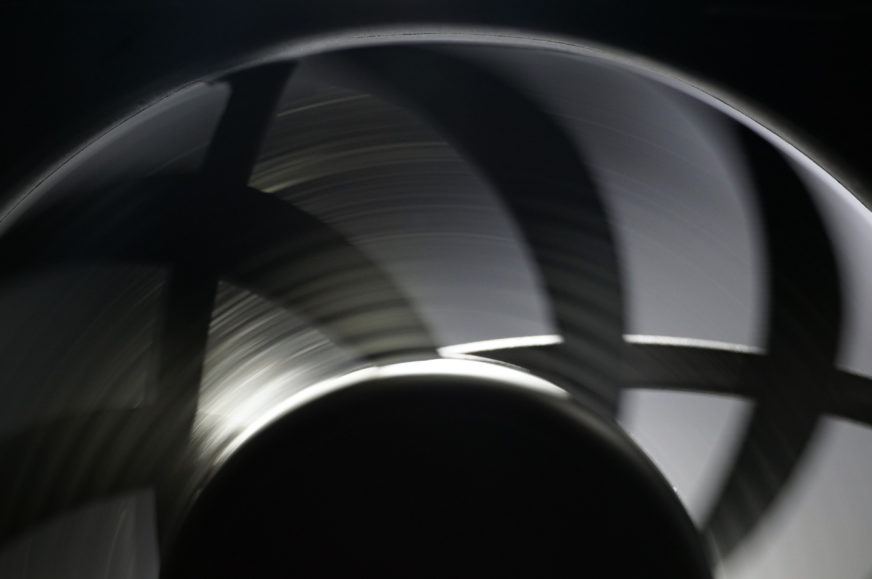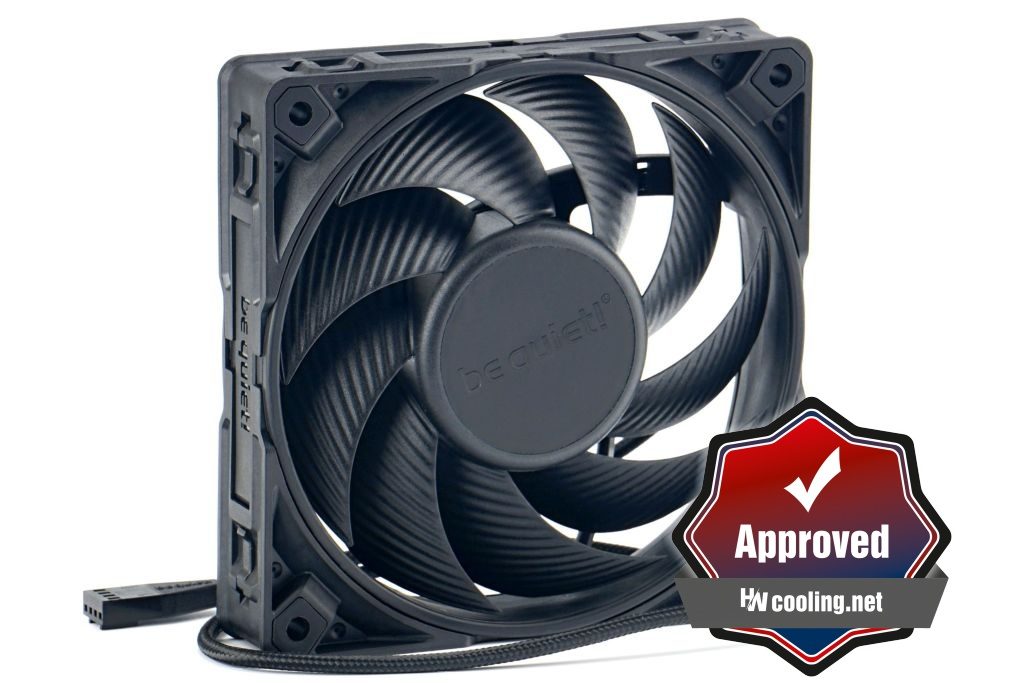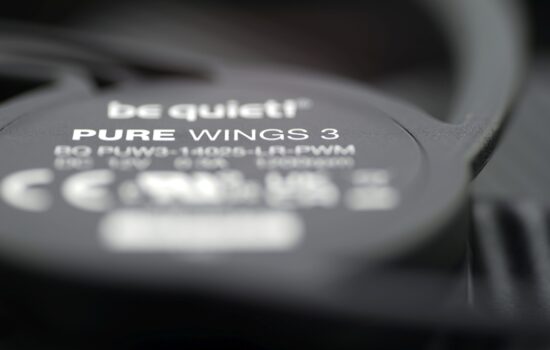Evaluation
All the secrets around the BeQuiet! Silent Wings (Pro) 4 are over and the detailed analyses of the sub-features begin. And it’s great that we can be a part of it. This is, after all, without a doubt, the biggest “cooling” event of the year, and it’s spicier than we thought. The new BeQuiet! fans may be the absolute top of the line, but they haven’t avoided certain imperfections that you have to take into account.
Evaluation
The performance of the 120 mm Silent Wings Pro 4 is supreme. The first sentence of the evaluation can’t sound any other way. Whatever the application, an overall contender for this fan is hard to find. On radiators, regardless of thickness and FPI, it always holds the top spots among the fans tested so far across the entire speed spectrum. And at low speeds, which are optimal for this fan, even with a good margin. That’s both against the Silent Wings 3, which also achieved the best price-to-noise ratio at low speeds, and with the structurally similar MSI Silent Gale P12. That fan outperforms the BeQuiet! only in very rare cases.
For example, in a no-obstacle situation (typically operating in a case without a grille and without a dust filter), the Silent Wings Pro 4 does deliver top performance, but it only scores at top speed at the cost of top noise. In the normalized modes to equal noise level, besides the Silent Gale P12, it even ranks below the SilentiumPC Fluctus 120 PWM or the Arctic BioniX F120. It’s always very tight, but it does. In any case, the obstacle-free mode is where Silent Wings Pro 4 is relatively weakest compared to the competition.
The strengths and dominance of this fan come only in applications where higher static pressure is key compared to the competition. And a fan can’t do without it even on a dust filter. Using the nylon one, it’s at the front of the peloton as well as on the plastic filter at low speeds of around 750 rpm. Even the most powerful PC builds don’t need higher airflow, especially with a larger number of fans, to circulate air. Given the trend of increasing efficiency with decreasing speed, it’s a bit of a shame that you can’t get the fan below 620 rpm, which is its lower limit.
For more intensive system cooling at higher speeds, the Silent Wings Pro 4 is no longer very suitable. Not because the performance doesn’t scale with higher speeds (it does), but In modes aligned to higher fixed dBA levels, the BeQuiet! fan starts to fall a bit behind..This is due to the higher intensity of noise at frequencies that are amplified due to the oscillation of the blades by flexing. At lower speeds it’s still nothing critical, but it does cost the Silent Wings Pro 4 the top spot, and in the 36 dBA mode with a plastic filter it doesn’t outperform even the SW3.
For reasons similar to the above, the Silent Wings Pro 4 is “just the next one in line” on the hexagonal grille as well. Here, there are more of those reasons for the weaker placement, and aerodynamic noise from microturbulence at the edges of the grille comes into play more prominently here. It’s also a little higher compared to the BioniX P120 A-RGB, but Silent Wings Pro 4’s performance in the quietest mode is still good enough for a top three. The BioniX P120 A-RGB in turn performs worse on a nylon filter, so the elite system fan status belongs duly to the Silent Wings 4 Pro. It is also an extremely effective system fan when used on a radiator of a liquid cooler. It delivers other than the best results only at higher speeds, from 1270 rpm upwards. There again, as you already know, this is due to the sound from the unfortunately flexing blades.
Because of the robust rotor and its overall sturdy fit, the vibrations from this mechanical motion are effectively transmitted to the frame. From there, then to the case and so on. The relatively high vibration intensity is quite surprising for a fan of this calibre. However, the secondary noise (by vibrating the cabinet) can be damped by an anti-vibration mount. To what extent this is, we will discuss later in an article, which will be separate from the standard tests.
The sound, which betrays the Silent Wings 4 Pro’s otherwise excellent performance at higher speeds, is at around 340 Hz. In some cases, at some speeds (again, typically higher) the dominant frequency across the octaves shifts towards a more rumbly 200 Hz. On radiators, for example. With this, we had more serious complaints about the SPC Fluctus 120 PWM as well, but that one’s even rumblier. However, the Silent Wings Pro 4 is 2.5 times more expensive, so the screwup is at least similar.
But not to make it look like the new BeQuiet! fan is being criticized more than it deserves, the following should be bolded. When used correctly, with optimum speed settings, the Silent Wings Pro 4 guarantees no-compromise performance (both cooling-wise and acoustically), whether you use it as a system fan or to cool radiator fins. For a while we also considered the rarest HWCooling award, but to give it some weight, out of a hundred fans, it might go to two, three at the most, which after all will be a bit better tuned than the Silent Wings Pro 4. With this fan, considering the speed and the good-looking design of the motor, the power draw is a bit too high. This then results in a below average ratio of airflow per watt. These details may not interest many people anymore, but when it all adds up, there is still room for improvement.
English translation and edit by Jozef Dudáš
| BeQuiet! Silent Wings Pro 4 (BL098) |
| + Suitable for every use |
| + Cooling efficiency (airflow/pressure per unit of noise) at a very high level |
| + No-compromise radiator cooling performance regardless of speed |
| + High airflow and static pressure even through an obstacle... |
| + ... efficiency at low speeds (below 1000 rpm) is top-notch |
| + Very wide speed range plus passive operation |
| + Virtually noiseless operation of bearings and motor (no non-aerodynamic noises) |
| + Decent build quality... |
| + ... with emphasis on high cable durability |
| + Extremely powerful motor (almost 10 W) |
| + Interchangeable mounting corners. Up to three types to suit the specific application... |
| + ... and finally with an elegant (de)mounting system |
| + Assumption of a very long service life |
| - Higher minimum speed (~620 rpm) |
| - At higher speeds, more pronounced frequency peaks at rumblier frequencies |
| - Relatively high vibration transmitted to the frame |
| - Lower power efficiency. Higher power draw in relation to speed and airflow |
| Approximate retail price: 32 EUR |
- Contents
- BeQuiet! Silent Wings Pro 4 (BL098) in detail
- The basis of the methodology, the wind tunnel
- Mounting and vibration measurement
- Initial warm-up and speed recording
- Base 7 equal noise levels…
- .. and sound color (frequency characteristic)
- Static pressure measurement…
- … and airflow
- Everything changes with obstacles
- How we measure power draw and motor power
- Measuring the intensity (and power draw) of lighting
- Results: Speed
- Results: Airlow w/o obstacles
- Results: Airflow through a nylon filter
- Results: Airflow through a plastic filter
- Results: Airflow through a hexagonal grille
- Results: Airflow through a thinner radiator
- Results: Airflow through a thicker radiator
- Results: Static pressure w/o obstacles
- Results: Static pressure through a nylon filter
- Results: Static pressure through a plastic filter
- Results: Static pressure through a hexagonal grille
- Results: Static pressure through a thinner radiator
- Results: Static pressure through a thicker radiator
- Results: Static pressure, efficiency by orientation
- Reality vs. specifications
- Results: Frequency response of sound w/o obstacles
- Results: Frequency response of sound with a dust filter
- Results: Frequency response of sound with a hexagonal grille
- Results: Frequency response of sound with a radiator
- Results: Vibration, in total (3D vector length)
- Results: Vibration, X-axis
- Results: Vibration, Y-axis
- Results: Vibration, Z-axis
- Results: Power draw (and motor power)
- Results: Cooling performance per watt, airflow
- Results: Cooling performance per watt, static pressure
- Airflow per euro
- Static pressure per euro
- Results: Lighting – LED luminance and power draw
- Results: LED to motor power draw ratio
- Evaluation













Hi. Do you have any idea of why this fan is capped at 2800rpm at 100%PWM speed? I can see in the test results that you are getting 2800rpm max as I do, but do you know why? All three of my fans are capped at 2800rpm.
Obviously this is caused by the limitations of the fan electronics. At 12,00 V (DC/PWM) the approx. 2800 rpm is simply a ceiling. Most of the BeQuiet! fans we have tested do not reach the max. specified speed. They always just fit within the +/- 10 % tolerance. Anyway, we will address your question to BeQuiet! and if we get an answer, we will write it here in the discussion, but the fact is that most fans are a bit faster compared to the parameters and BeQuiet! has it the other way around.